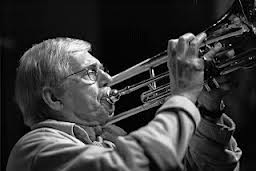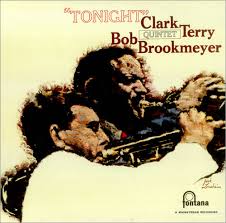Hum – Bob Brookmeyer
Based on an ascending modal structure, this medium-up song is as lyrical as the title implies. There are rhythm section hits not only through the head but also on part of the solo chorus.
- Recording: Clark Terry-Bob Brookmeyer - Tonight
- Recorded on: November 23-24, 1964
- Label: Mainstream (M56043)
- Concert Key: G minor
- Vocal Range: , to
- Style: Swing (medium up)
- Flugelhorn, Trumpet - Clark Terry
- Trombone - Bob Brookmeyer
- Piano - Roger Kellaway
- Bass - Bill Crow
- Drums - Dave Bailey
- Description
- Historical Notes
- Solos
- Piano Corner
- Bass Corner
- Drum Corner
- Guitar Corner
- Inside & Beyond
- Minus You
Lyrical in a modal style, this song certainly has a melody worth humming. The melody, however, is only part of the story: this is a song with plenty of rhythm section activity. A series of hits goes throughout the 32-measure head, which has an AABA structure in both melody and rhythm section figures but shifts up a half step every eight measures.
Though at first glance this appears to be a head with a lot of changes, the chord hits are mostly shifting structures over pedal points. The modes in this song are all Dorian, on G, G♯, A, and B♭. However, the bass pedals are on the 4th—C pedal for G Dorian, for example—except on the bridge (C in our lead sheet) where the hits are all on Cmaj7 alternating A and D in the bass. A♭m7 in the second half of the last measure, in both head and solo choruses, leads back to G Dorian for the start of the next chorus.
The rhythm section activity doesn't stop once it gets to the solos. The rhythm section swings in the first half of the solo chorus, eight measures of Gm7 and eight of G♯m7 (on the recording Bob Brookmeyer's first solo chorus starts with 2-feel, and other choruses with 4-feel). The bridge of the solo chorus has hits with breaks as on the head, while in the last eight measures the rhythm section plays staccato quarter notes on B♭m7, starting quietly with a steady crescendo. This breaking up of the solo chorus is guaranteed to make blowing more creative.
There is an eight-measure intro in which the rhythm section establishes the hits that continue on the A section. The coda is also eight measures of G Dorian, with a melody based on the third and fourth measures of the head over a simpler set of rhythm section hits.
Though at first glance this appears to be a head with a lot of changes, the chord hits are mostly shifting structures over pedal points. The modes in this song are all Dorian, on G, G♯, A, and B♭. However, the bass pedals are on the 4th—C pedal for G Dorian, for example—except on the bridge (C in our lead sheet) where the hits are all on Cmaj7 alternating A and D in the bass. A♭m7 in the second half of the last measure, in both head and solo choruses, leads back to G Dorian for the start of the next chorus.
The rhythm section activity doesn't stop once it gets to the solos. The rhythm section swings in the first half of the solo chorus, eight measures of Gm7 and eight of G♯m7 (on the recording Bob Brookmeyer's first solo chorus starts with 2-feel, and other choruses with 4-feel). The bridge of the solo chorus has hits with breaks as on the head, while in the last eight measures the rhythm section plays staccato quarter notes on B♭m7, starting quietly with a steady crescendo. This breaking up of the solo chorus is guaranteed to make blowing more creative.
There is an eight-measure intro in which the rhythm section establishes the hits that continue on the A section. The coda is also eight measures of G Dorian, with a melody based on the third and fourth measures of the head over a simpler set of rhythm section hits.
Vocalist/lyricist Judy Niemack added a lyric to Hum to create You; check out this song for an exclusive recording with a Minus You track for vocals or instrumentals.
Like Pretty Girl, this song was next recorded on a BBC broadcast in London in 1965 with a local rhythm section. Another live recording comes from the Half Note in New York with the same lineup as "Tonight."
Earlier in November 1964, pianist Roger Kellaway played on two recordings for the Impulse label at Van Gelder Studio in Englewood Cliffs, New Jersey. November 10th and 11th were the sessions for Oliver Nelson's classic album "More Blues And The Abstract Truth," while on the 13th and 20th Kellaway was back at Van Gelder's for "Happiness" by the Russian Jazz Quartet co-led by saxophonist Boris Midney and bassist Igor Berukshtis. Also in 1964, Kellaway played on Terry's first Impulse album "The Happy Horns Of Clark Terry," again at Van Gelder's.
Like Pretty Girl, this song was next recorded on a BBC broadcast in London in 1965 with a local rhythm section. Another live recording comes from the Half Note in New York with the same lineup as "Tonight."
Earlier in November 1964, pianist Roger Kellaway played on two recordings for the Impulse label at Van Gelder Studio in Englewood Cliffs, New Jersey. November 10th and 11th were the sessions for Oliver Nelson's classic album "More Blues And The Abstract Truth," while on the 13th and 20th Kellaway was back at Van Gelder's for "Happiness" by the Russian Jazz Quartet co-led by saxophonist Boris Midney and bassist Igor Berukshtis. Also in 1964, Kellaway played on Terry's first Impulse album "The Happy Horns Of Clark Terry," again at Van Gelder's.
Related Songs
Email Send Hum to a friend
Send this page to a friend via email. Add your name or email in the first field. In the second, add one or more email addresses, separated by a comma.

Bob Brookmeyer
December 19, 1929 – December 15, 2011
American jazz trombonist Robert Brookmeyer was one of the top valve trombonists and advanced arrangers of his time. Born in Kansas City, Missouri, he started as a pianist in dance bands, winning the Carl Busch Prize for Choral Composition during his attendance at Kansas City Conservatory of Music. Read more...
There was a problem.
...



